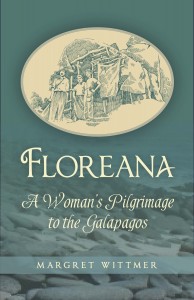 Like author Johanna Angermeyer, writer Margret Wittmer spent decades learning the intricacies and challenges of learning to live in the Galapagos islands. Unlike Angermeyer, though, Wittmer’s infrastructure was non-existent to the point that she and her small family had to create everything from scratch. As detailed in Floreana: A Woman’s Pilgrimage to the Galapagos (2013, ISBN 978-1-55921-399-8) her life was caught up in a series of triumphs and tragedies that for a time involved World War II. She and her family survived to create a sustainable tourism culture on the remote island of Floreana, the history of which also involved a well-known disappearance and possible murder. Margret, her husband Heinz, and stepson Harry left their home in Cologne, Germany and arrived in Floreana in August of 1932. They were loaded with numerous supplies:
Like author Johanna Angermeyer, writer Margret Wittmer spent decades learning the intricacies and challenges of learning to live in the Galapagos islands. Unlike Angermeyer, though, Wittmer’s infrastructure was non-existent to the point that she and her small family had to create everything from scratch. As detailed in Floreana: A Woman’s Pilgrimage to the Galapagos (2013, ISBN 978-1-55921-399-8) her life was caught up in a series of triumphs and tragedies that for a time involved World War II. She and her family survived to create a sustainable tourism culture on the remote island of Floreana, the history of which also involved a well-known disappearance and possible murder. Margret, her husband Heinz, and stepson Harry left their home in Cologne, Germany and arrived in Floreana in August of 1932. They were loaded with numerous supplies:
We had made arrangements to sell the flat, and had invested all our savings in equipment and supplies, notably a good set of tools both for agriculture and household use and plenty of food stores. We took two hundredweights each of rice and beans, one hundredweight of flour, twenty-five pounds each of coffee and Quaker oats, five pounds of cocoa, plus three bottles of brandy, washing soap, matches, oil, tinned milk, and potatoes and onions for planting, a bale of yellow material for extra clothing needs, and a typewriter, in case any of our experiences should be worth putting down on paper. While we were in Chatham [island], we bought many more seeds and plants: sugarcane, yucca (a sort of tapioca), banana shoots, coffee beans, otois and camotes (two sorts of sweet potato), pineapple, pumpkins, mangos, papaws, avocados, and a cock and two hens.
The Wittmers began their life in Floreana by living in a cave. Among their first acquaintances were Dr. Friedrich Ritter and his girlfriend Dore Strauch, naturists and alleged vegetarians who’d had their teeth removed and replaced with stainless steel dentures before arriving on the island. Eventually a woman who called herself “Baroness” Eloise Wehrborn de Wagner-Bousquet of Vienna arrived with two lovers, an attendant, and grandiose plans to set up a resort. The Ritters and the Baroness did not get along, and eventually, in March of 1934, the Baroness and her colleagues disappeared, allegedly having siled away by boat, bound for Tahiti. They were never heard from again, and Wittmer suspected Ritter may have had a hand in the disappearance. The mystery has never been solved.
 Later that year, Ritter died too, of food poisoning. Recounting his death, Wittmer noted that Ritter seemed to want to have nothing to do with Dore while on his deathbed. Another unsolved mystery.
Later that year, Ritter died too, of food poisoning. Recounting his death, Wittmer noted that Ritter seemed to want to have nothing to do with Dore while on his deathbed. Another unsolved mystery.
Margret and Heinz Wittmer had two additional children, born on Floreana. They worked hard, prospered, and hosted thousands of visitors, eventually founding an inn which still exists on the island. Son Harry disappeared after a boat accident one year, Heinz died in 1963, and Margret completed this book in 1982. She passed away in 2000, at the age of 96 and son Rolf in 2012. Daughter Inge continues to run the lodge
While many dream of having a Robinson Crusoe-like existence, the Wittmers lived it, and Margret’s story brings a heavy dose of reality to the fantasy. At one time or another, they were at odds with the American, Ecuadorian, and German governments, then made up. Neighbors could be both a trial and a lifeline. Wild animals, particularly bulls, were a terror one moment and food the next.
John Woram has compiled a wonderful bibliography of books, journals, and manuscripts written on the subject of the Galapagos. A great start is Margret Wittmer’s Floreana, a true adventure tale that reads like a novel. Buy it now at the WoWasis eStore.
Leave a Reply